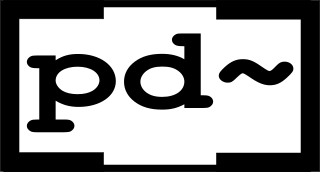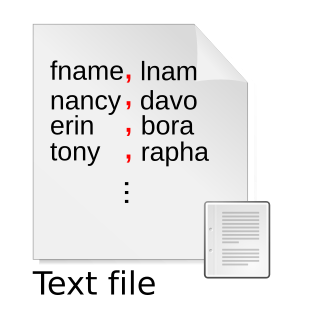Lexical tokenization is conversion of a text into meaningful lexical tokens belonging to categories defined by a "lexer" program. In case of a natural language, those categories include nouns, verbs, adjectives, punctuations etc. In case of a programming language, the categories include identifiers, operators, grouping symbols and data types. Lexical tokenization is related to the type of tokenization used in Large language models (LLMs), but with two differences. First, lexical tokenization is usually based on a lexical grammar, whereas LLM tokenizers are usually probability-based. Second, LLM tokenizers perform a second step that converts the tokens into numerical values.
A string literal or anonymous string is a literal for a string value in the source code of a computer program. Modern programming languages commonly use a quoted sequence of characters, formally "bracketed delimiters", as in x = "foo", where "foo" is a string literal with value foo. Methods such as escape sequences can be used to avoid the problem of delimiter collision and allow the delimiters to be embedded in a string. There are many alternate notations for specifying string literals especially in complicated cases. The exact notation depends on the programming language in question. Nevertheless, there are general guidelines that most modern programming languages follow.
In computer programming, Base64 is a group of binary-to-text encoding schemes that transforms binary data into a sequence of printable characters, limited to a set of 64 unique characters. More specifically, the source binary data is taken 6 bits at a time, then this group of 6 bits is mapped to one of 64 unique characters.
A carriage return, sometimes known as a cartridge return and often shortened to CR, <CR> or return, is a control character or mechanism used to reset a device's position to the beginning of a line of text. It is closely associated with the line feed and newline concepts, although it can be considered separately in its own right.

A newline is a control character or sequence of control characters in character encoding specifications such as ASCII, EBCDIC, Unicode, etc. This character, or a sequence of characters, is used to signify the end of a line of text and the start of a new one.
Direct Client-to-Client (DCC) is an IRC-related sub-protocol enabling peers to interconnect using an IRC server for handshaking in order to exchange files or perform non-relayed chats. Once established, a typical DCC session runs independently from the IRC server. Originally designed to be used with ircII it is now supported by many IRC clients. Some peer-to-peer clients on napster-protocol servers also have DCC send/get capability, including TekNap, SunshineUN and Lopster. A variation of the DCC protocol called SDCC, also known as DCC SCHAT supports encrypted connections. An RFC specification on the use of DCC does not exist.
uuencoding is a form of binary-to-text encoding that originated in the Unix programs uuencode and uudecode written by Mary Ann Horton at the University of California, Berkeley in 1980, for encoding binary data for transmission in email systems.

Pure Data (Pd) is a visual programming language developed by Miller Puckette in the 1990s for creating interactive computer music and multimedia works. While Puckette is the main author of the program, Pd is an open-source project with a large developer base working on new extensions. It is released under BSD-3-Clause. It runs on Linux, MacOS, iOS, Android and Windows. Ports exist for FreeBSD and IRIX.

Comma-separated values (CSV) is a text file format that uses commas to separate values, and newlines to separate records. A CSV file stores tabular data in plain text, where each line of the file typically represents one data record. Each record consists of the same number of fields, and these are separated by commas in the CSV file. If the field delimiter itself may appear within a field, fields can be surrounded with quotation marks.

A delimiter is a sequence of one or more characters for specifying the boundary between separate, independent regions in plain text, mathematical expressions or other data streams. An example of a delimiter is the comma character, which acts as a field delimiter in a sequence of comma-separated values. Another example of a delimiter is the time gap used to separate letters and words in the transmission of Morse code.
Modbus or MODBUS is a client/server data communications protocol in the application layer. It was originally published by Modicon in 1979 for use with its programmable logic controllers (PLCs). Modbus has become a de facto standard communication protocol for communication between industrial electronic devices in a wide range of buses and network.
Client-to-client protocol (CTCP) is a special type of communication between Internet Relay Chat (IRC) clients.
The data URI scheme is a uniform resource identifier (URI) scheme that provides a way to include data in-line in Web pages as if they were external resources. It is a form of file literal or here document. This technique allows normally separate elements such as images and style sheets to be fetched in a single Hypertext Transfer Protocol (HTTP) request, which may be more efficient than multiple HTTP requests, and used by several browser extensions to package images as well as other multimedia content in a single HTML file for page saving. As of 2024, data URIs are fully supported by all major browsers.
A whitespace character is a character data element that represents white space when text is rendered for display by a computer.
A binary-to-text encoding is encoding of data in plain text. More precisely, it is an encoding of binary data in a sequence of printable characters. These encodings are necessary for transmission of data when the communication channel does not allow binary data or is not 8-bit clean. PGP documentation uses the term "ASCII armor" for binary-to-text encoding when referring to Base64.
.properties is a file extension for files mainly used in Java-related technologies to store the configurable parameters of an application. They can also be used for storing strings for Internationalization and localization; these are known as Property Resource Bundles.
Chunked transfer encoding is a streaming data transfer mechanism available in Hypertext Transfer Protocol (HTTP) version 1.1, defined in RFC 9112 §7.1. In chunked transfer encoding, the data stream is divided into a series of non-overlapping "chunks". The chunks are sent out and received independently of one another. No knowledge of the data stream outside the currently-being-processed chunk is necessary for both the sender and the receiver at any given time.
This comparison of programming languages compares the features of language syntax (format) for over 50 computer programming languages.
JSON streaming comprises communications protocols to delimit JSON objects built upon lower-level stream-oriented protocols, that ensures individual JSON objects are recognized, when the server and clients use the same one. This is necessary as JSON is a non-concatenative protocol.
Acorn System BASIC and Atom BASIC are two closely related dialects of the BASIC programming language developed by Acorn Computers for their early microcomputers like the Acorn System 3 and Acorn Atom. Developed in-house, they have a number of significant idiosyncrasies compared to most BASIC dialects of the home computer era.



